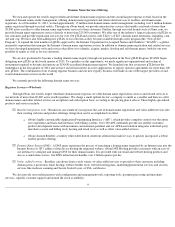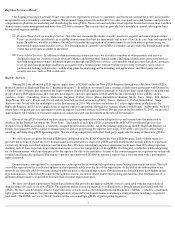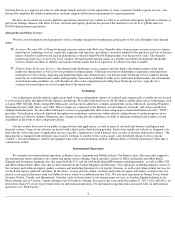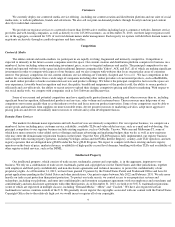Enom 2013 Annual Report Download - page 17
Download and view the complete annual report
Please find page 17 of the 2013 Enom annual report below. You can navigate through the pages in the report by either clicking on the pages listed below, or by using the keyword search tool below to find specific information within the annual report.
for cost-per-click advertising on our owned and operated websites and on our network of customer websites. In addition, Google’s access to
more comprehensive data regarding user search queries through its search algorithms would give it a significant competitive advantage over
everyone in the industry, including us. If this data is used competitively by Google, sold to online publishers or given away for free, our business
may face increased competition from companies, including Google, with substantially greater resources, brand recognition and established
market presence.
In addition to Google, many of our current and other potential competitors enjoy substantial competitive advantages, such as greater name
recognition, longer operating histories, substantially greater financial, technical and other resources and, in some cases, the ability to combine
their online marketing products with traditional offline media such as newspapers or magazines. These companies may use these advantage s to
offer products and services similar to ours at a lower price, develop different products to compete with our current offerings and respond more
quickly and effectively than we can to new or changing opportunities, technologies, standards or customer requirements. For example, both AOL
and Yahoo! may have access to proprietary search data which could be utilized to assist them in their content creation processes. In addition,
many of our current and potential competitors have established marketing relationships with and access to larger customer bases. For all of these
reasons, we may not be able to compete successfully against our current and potential competitors.
Historically, the success of our content and media service offering has been closely tied to the success of eHow, so if eHow
’s performance
falters, it could have a material adverse effect on our business, financial condition and results of operations.
For the years ended December 31, 2013 and 2012, we generated approximately 30 % and 31%, respectively, of our revenue from eHow.
No other individual content and media website was responsible for more than 10% of our revenue in these periods. eHow depends on various
Internet search engines to direct traffic to the site. For the year ended December 31, 2013, we estimate that approximately half of eHow’s traffic
came from Google searches. The success of eHow could be adversely impacted by a number of factors, including further changes in search
engine algorithms or methodologies similar to those previously implemented by Google, some of which negatively impacted search referral
traffic to eHow and caused a reduction in page views on eHow; our failure to properly manage SEO efforts for eHow; our failure to prevent
internal technical issues that disrupt traffic to eHow; or reduced reliance by Internet users on search engines to locate relevant content.
Additionally, as we continue to evaluate and improve the user experience on eHow, we may make changes to eHow’s layout or features with
respect to content and advertisement displays that are designed to improve the consumer experience, but which could negatively impact
monetization efforts. We have also already produced a significant amount of content that is housed on eHow and it has become difficult for us to
continue to identify topics and produce content with the same level of broad consumer appeal as the content we have produced up to this point.
A decline in eHow’s performance could result in a material adverse effect to our business, financial condition and results of operations.
Poor perception of our brands or business could harm our reputation and adversely affect our business, financial condition and results of
operations.
Our content and media business is dependent on attracting a large number of visitors to our owned and operated websites and our network
of customer websites and providing leads and clicks to our advertisers, which depends in part on our reputation within the industry and with our
users. Because part of our business is transforming
traditional content creation models and is therefore not easily understood by casual observers,
our brands, business and reputation are vulnerable to poor perception. For example, perception that the quality of our content may not be the
same or better than that of other published Internet content, even if baseless, can damage our reputation. We are frequently the subject of
unflattering reports in the media about our business and our model. Any damage to our reputation could harm our ability to attract and retain
advertisers, visitors, customers, freelance creative professionals and artists, which would materially adversely affect our results of operations,
financial condition and business. Furthermore, certain of our owned and operated websites, such as Livestrong.com and eHow, as well as some
of the content we produce for our network of customer websites, are associated with high-profile experts to enhance brand recognition and
credibility. Any adverse news reports, negative publicity or other alienation of all or a segment of our consumer base relating to these high-
profile experts would reflect poorly on our brands and could have a material adverse effect on our business. For example, Livestrong.com is a
licensed trademark from the Livestrong Foundation, which is the charitable foundation created by Lance Armstrong to promote cancer
awareness and healthy lifestyles. While negative publicity surrounding Lance Armstrong has not had a material impact on the performance of
Livestrong.com to date, there can be no assurance that these events will not have a material adverse effect on its traffic and monetization in the
future.
We rely primarily on freelance creative professionals and artists for a majority of our online content. We may not be able to attract or retain
sufficient creative professionals and artists to generate content on a scale or of a quality sufficient to grow or maintain our business,
including our commerce initiatives.
We rely primarily on freelance creative professionals for the content that we distribute through our owned and operated websites and our
network of customer websites, as well as on artists that upload their unique art designs to certain of our commerce websites, such as Society6.
We may not be able to attract or retain sufficien t qualified and experienced freelance creative professionals and artists to generate content on a
scale or of a quality sufficient to grow or maintain our business. For example, our premium video
15
























